Świętno
Borough of Wolsztyn , Wolsztyński District, Wielkopolskie VoivodshipType of place
Traffic laneInformation about the crime
We visited the Sława Forest Inspectorate in Wolsztyn County near the village of Rudno for the first time on January 28, 2022. We came to carry out a local inspection of the grave of a Jewish woman located between Wilcza and Świętno villages. We met with representatives of the Forest Inspectorate, local authorities and the Institute for National Remembrance branch in Poznań.
There was a plaque with a Star of David at the alleged grave site was a plaque with a Star of David and an information board attached to a tree that read as follows:
“In the autumn of 1944, the German extermination camps were evacuated. Such a fate befell the female inmates of the Auschwitz and Gross-Rosen camps. In the second half of October, they were transported to Sława Śląska by train in open cars, from where they reached the sub-camps near Stary Strącz after a three-hour march. They were placed in barns on three farms, numbering about 2,000 women from registry number 70,001 to 72,000.
They were placed in three farms-barns,, pigsties-in the number of about 2,000 women from registry number 70,001 to 72,000. The prisoners were of Jewish origin of Polish, Czech, Slovak, Hungarian, Dutch and Belgian nationalities. The women were used for heavy earthen work-digging anti-tank ditches. They were fed rutabaga, carrot and beet soup and black bread. […] They suffered from gastrointestinal diseases, purulent pneumonia, urinary diseases, meningitis and blood infection. Diseases, exhaustion from work and starvation contributed to the high mortality rate. […] The prisoners were Jewish women of Polish, Czech, Slovak, Hungarian, Dutch, Belgian nationalities. The women were used for heavy earthen labor – digging anti-tank trenches. […]The dead were buried on the edge of a nearby forest. According to preliminary information, about 100 women died there from exhaustion. […] On January 21, at 22:00, the order was given to evacuate and liquidate the camp. Columns of several hundred women prisoners were formed and chased along dirt roads along transportation routes. […] During the “Death March”, which lasted more than 3 months, female prisoners walked hundreds of kilometers moving through German villages and towns: Świętno, Jaromierz Stary and Jaromierz Nowy, Kargowa, Wojnowo, Sulechów, Zielona Góra, Nowa Sól […] Less than 100 women survived the march. The route of the “Death March” was dotted with numerous graves. Prisoners who fell due to exhaustion from work, disease, marching in low temperatures and were unable to go further were isolated and liquidated. There were two such cases in our area, which were confirmed by eyewitness testimony. […] […] At the beginning of the “Death March” near the village of Spokojna near Śmieszków, 20 women who could not walk were selected and shot. One survived the execution. Others were buried in a mass grave in the Wolsztyn cemetery. […]
The second case is related to the village of Stary Jaromierz, where the tragic event took place. The incident was witnessed by Florian Drzymała (born 1925), who was directed about work in Stary Jaromierz by the Arbeitsamt. A column of 700-800 people stopped near the school. Meanwhile, 38 of the weakest prisoners with frostbitten legs were selected and the village leader was ordered to provide wagons to transport the prisoners ostensibly to a hospital in Konotop. In fact, they were taken to the woods in the direction of Nowy Jaromierz under the escort of seven drunk executioners. The women were shot in a place 1 kilometer away from Stary Jaromierz. Eyewitness Florian Drzymała testified that in August 1960, the remains of the prisoners were exhumed and buried in the cemetery in Kargowa”.
Almost nothing is known about the woman buried by the roadside 1 km from Rudan, except that she was a participant in the Death March. Maciej Łakomy, the mayor of the village of Wilcze, has been striving for years for the woman to be properly commemorated. In January 2022, he met us at the unnamed grave and told us about the post-war history of the site and his commitment to commemorate the Jewish prisoner:
“Maybe it’s a hand of fate. I was working as a driver in international transportation. One night I woke up and remembered this grave. I remembered that it was there. I only knew that it was the grave of a Jewish woman. That’s the only thing that people knew. I came here to visit my in-laws for Christmas. I remembered this place. My father-in-law worked in the forestry division at the time. First he was a gamekeeper, later he became a sub-forester. I marked the spot and asked him if this was the place. He confirmed that it was.
– What did this grave look like in the 1950s and 1960s?
– There was a mound and a tin plaque with an inscription written in oil paint.
– Was there a cross with a white plaque?
– Yes. The white plaque and the cross. In the 1950s there was still a wreath hanging there. Later it was no longer there. It probably fell apart. (January 28, 2022)
IDENTIFICATION OF THE GRAVE BASED ON NON INVASIVE RESEARCH
In 2024, a site inspection was carried out in a place precisely indicated as the grave of a single victim (GPS: N 52°00.633′ E 016°00.560′ / annex Świętno, photo 1 of the location). The area in which the grave is located is forested, the grave itself, according to information and preserved archival photography (annex: Świętno archival photograph of the grave), was located in the light of a forest road that is still in operation today (annex: Świętno, photograph of 3 locations). Reference points in the field are road no. . 314 running along the east-west axis, at a distance of approx. 35.0 meters from the indicated location of the grave located northwards, perpendicular to road no. 314. Moreover, a forest road running parallel to road no. 314 is another reference point located approximately 12.0 m from the indicated location. An archival photograph of the location of the commemorated grave recorded a characteristic hill on which young pines grow, the topography of the area from several dozen years ago coincides with the current appearance of the area.
To investigate the indicated location, a MALA X3M RAMAC GPR (500 Mhz) was used. Three GPR profiles were made, named: SWE10001, SWE10002 and SWE10003. Data were collected along the road in the south-eastern axis, in parallel routes crossing the indicated grave site. The location of the burial place is at 11.0 – 13.0 meters of the SWE10001-SWE10003 profiles (marked with red arrows in the attachment called Świętno GPR profile). The anomaly occurring in the indicated place is probably the profile of the original burial pit excavation with a length of approx. 1.8 – 2.0 m, the presumed width is approx. 0.60 – 0.70 m, the depth of the anomaly is approx. 0.70 – 0.90 m (ground level).
Relief measurement (LiDAR) is not helpful in this case due to the lack of a visible sinkhole as a remnant of the original burial pit excavation. No query was carried out on archival aerial photos due to the small format of the grave, the violation of which would not be possible to interpret at the scales at which the archival aerial photos appear.
The research conducted in 2024 was financed by the European Union NextGenerationEU.
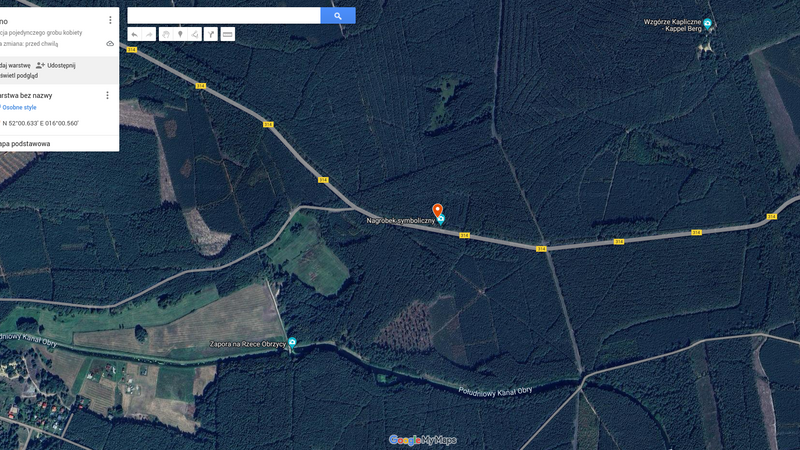 Świętno fotografia satelitarna 1a
Świętno fotografia satelitarna 1a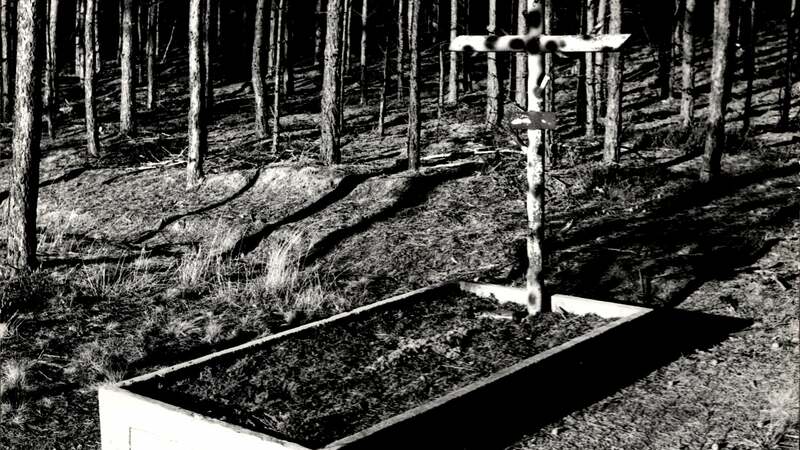 Świętno fotografia archiwalna grobu
Świętno fotografia archiwalna grobu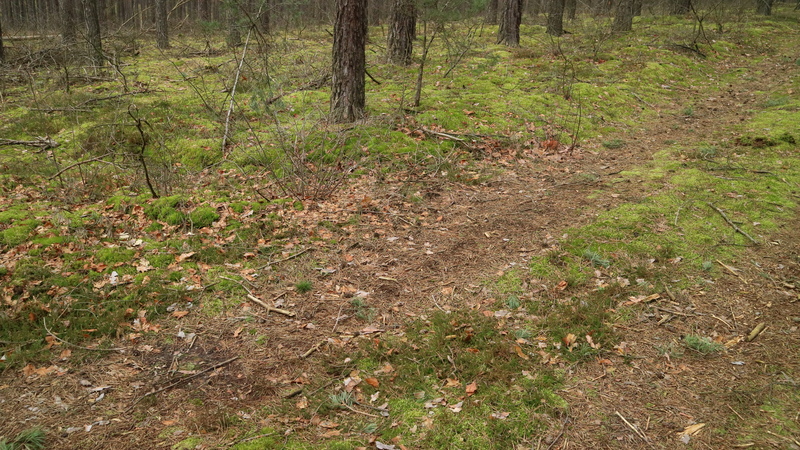 Świętno fotografia 1 lokalizacji
Świętno fotografia 1 lokalizacji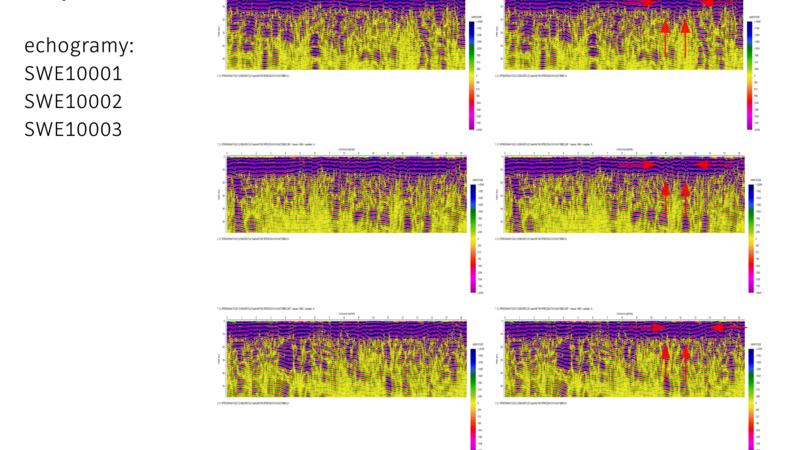 Świętno gpr profile
Świętno gpr profileSources
Contact and cooperation
We are still looking for information on the identity of the victims and the location of Jewish graves in Świętno. If you know something more, write to us at the following address: fundacjazapomniane@gmail.com.
Bibliography
Recording of the Zapomniane Foundation (audio file), name: Maciej Łakomy, village mayor of Wilcze, topic and key words: grave of a Jewish prisoner, Death March, interviewed by Agnieszka Nieradko and Andrzej Jankowski, January 28, 2022.
We have collected the materials about this village thanks to the funding provided by the International Holocaust Remembrance Alliance as part of the project “The rural Holocaust. Collecting and safeguarding the never recorded testimonies 100 forgotten Jewish graves 2021-2022”. The materials for this website were developed, digitized and made available as part of the project “Development of a digital archive of Jewish war graves outside the extermination camps and educational use of archive resources” thanks to funding from the Minister of Culture and National Heritage from the Cultural Promotion Fund.
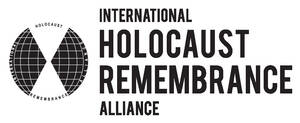

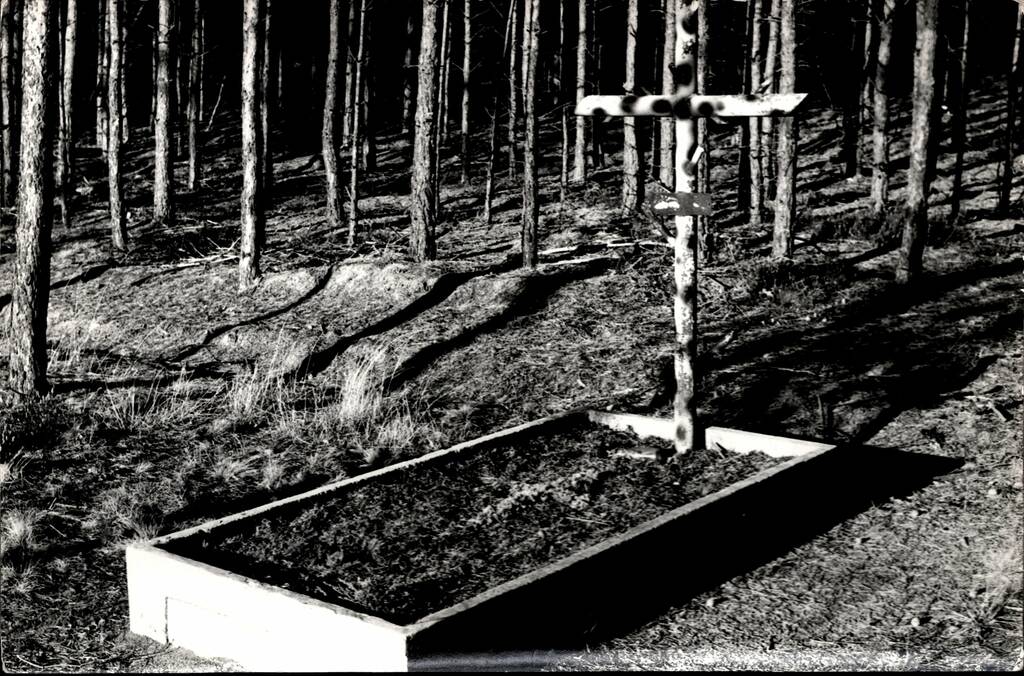 Świętno fotografia archiwalna grobu
Świętno fotografia archiwalna grobu